An Inventory of the Historical Monuments in the Town of Stamford. Originally published by Her Majesty's Stationery Office, London, 1977.
This free content was digitised by double rekeying. All rights reserved.
'High Street', in An Inventory of the Historical Monuments in the Town of Stamford(London, 1977), British History Online https://prod.british-history.ac.uk/rchme/stamford/pp81-90 [accessed 19 April 2025].
'High Street', in An Inventory of the Historical Monuments in the Town of Stamford(London, 1977), British History Online, accessed April 19, 2025, https://prod.british-history.ac.uk/rchme/stamford/pp81-90.
"High Street". An Inventory of the Historical Monuments in the Town of Stamford. (London, 1977), British History Online. Web. 19 April 2025. https://prod.british-history.ac.uk/rchme/stamford/pp81-90.
High Street (Fig. 100)
High Street was the axial road of the Danish burh. In the Middle Ages the Butcher Row was in the middle of the road, at its E. end, and almost opposite St. Michael's Church; there was a conduit which shared the same supply as that in St. Paul's Street. A booth in Butcher Row was given to St. Michael's nunnery before 1250 (PRO, SC 11/426). The Shambles was rebuilt in 1751 at a cost of £176 (Chamberlains' Accounts) and a drawing by Nattes shows the new building to have had a long roof supported on posts and to have been open along the sides. In 1720 there were also 'drystandings and stalls' against the neighbouring shops (Ex. MS, 87/12). A new shambles and market was begun in 1804 and completed in 1808 on an adjacent site (61). High Street has always been of importance, and since at least the 18th century it has been the principal commercial street in the town. All buildings have been more or less drastically altered to suit them to the needs of the 19th and 20th-century shopkeepers.
Former Houses and Shops, No. 1, see mon. 279.
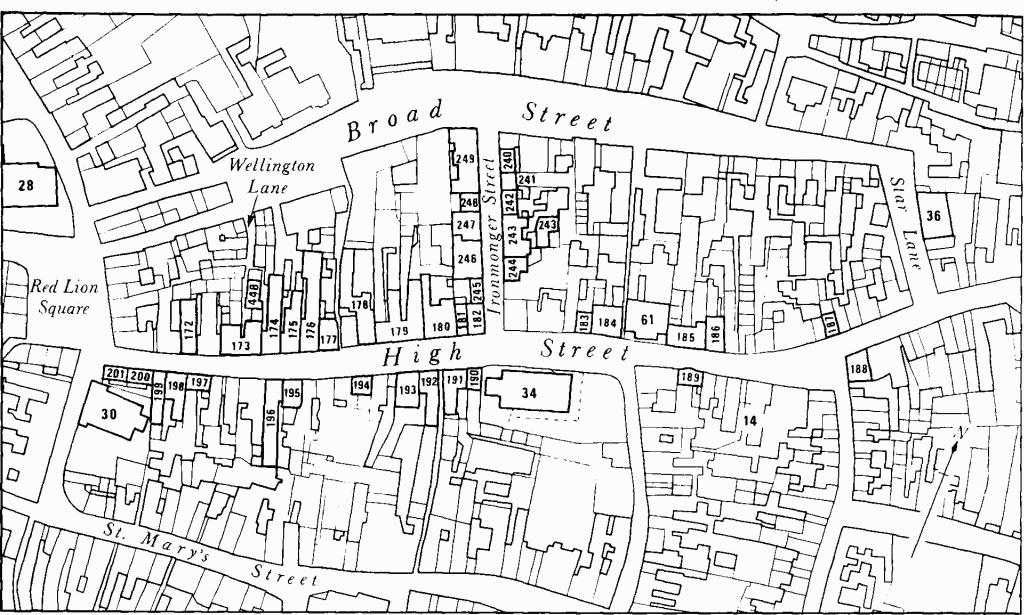
Fig. 100 Map showing monuments in High Street, Ironmonger Street and Wellington Lane.
(172) Shop, No. 3 (Fig. 101), three storeys, plastered red brick, comprises two blocks, running back from the street, now linked on the ground floor. It may be identified as the draper's shop, counting house and warehouse sold by Edward Thorpe to Garmston Chapman in 1824 (Mercury, 8 Oct. and 10 Dec.) and was probably built shortly before that date. The two-bay street block, with upper sash window, was formerly separated from the rear block by a narrow yard. This rear block has a timber-framed S. wall and the remainder is built of brick or stone. A fireplace has fluted surround and corner paterae.
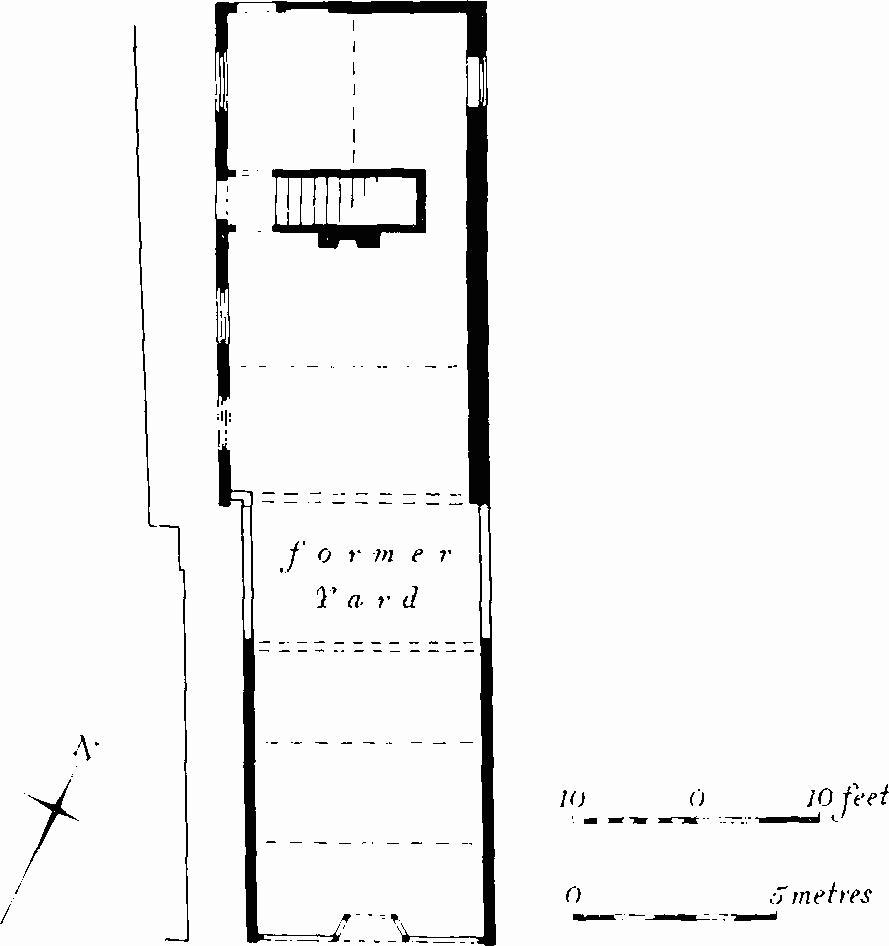
Fig. 101 (172) 3 High Street.
(173) Houses and Shops, Nos. 6–7 (Plate 106), two storeys and attics, have a rear range on the E., probably originally timber-framed, of the 17th century. The seven-bay main range was remodelled or rebuilt in the mid 18th century; the ashlar street front with separated quoins and first-floor sash windows, having moulded surrounds and stepped keystones, the central one fluted, was built at this time. A wooden moulded and bracketed cornice remains only over No. 7. The early 19th-century shop front to No. 7 (Plate 138) has a central doorway integral with flanking bow windows and entrances to side passages, one of which is now blocked; the cornice is concave over the doorways and convex over the windows. The E. passage served the house at the rear of the shop, and the W. is a public footpath known as Wellington Lane. The ground floor of No. 6 is gutted, but at the rear a timber-framed turret contains part of an early 19th-century stair. A first-floor room in No. 6 has early 19th-century beaded and panelled window reveals. A substantial moulded wooden bracket in a rear room of No. 7 has ornamental guttae, early 18th-century.
(174) House, No. 8 (Plate 110), three storeys and attics, red brick, gabled mansard roof, interior gutted, consists of two parallel ranges and a central linking block running back from the street. The rear range dates from the first half of the 18th century and the remainder was built in the 1760s. In 1768 the building, then the Globe Inn, was described as recently built (Mercury, 21 July), but the linking block appears to have been altered after that date.
The mid 18th-century street front of three bays breaking forward in the centre has two platbands, first-floor sash windows with lowered sills and modern iron balconies; the central window was originally wider and scars suggest it was of triple, possibly Venetian, form. The top-floor sash windows have moulded sills and shaped brick key-blocks; the central opening is a lunette, apparently original, with moulded brick architrave, key block and apron. The mansard roof and a wooden dentilled eaves cornice are early 19th-century. In each gable is a blind window with aprons and sills. The corresponding wing at the rear, also of three storeys and attics, is built of coursed rubble with freestone quoins, and has a gabled roof. The N. elevation (Plate 110) of three bays has platband, moulded string-course, coved eaves decorated with three demon masks and attenuated swags in plaster (Plate 122), and later sash windows with freestone dressings, perhaps of c. 1768. The attic floors are of plaster.
(175) House, No. 9, front block of three storeys, ashlar walls, is early 19th-century. The ground floor is gutted except for a side passage. The three-bay street front has sash windows and a plain rebuilt parapet. Inside, is an early 19th-century fireplace with cornerbosses. At rear is an 18th-century block with sash windows and 19th-century staircase; it was later extended at the rear to form a two-storey wing. In c. 1840 a narrow two-storey stone wing with attics was added beyond; its function is unknown.
(176) Gothic House, No. 10 (Fig. 102), mostly two storeys, comprises a long range running back from the street. It incorporates the rear wing of a large, probably 16th-century, house of which the S. end was replaced by the present mock-gothic building in 1849. At the rear of the early house is a block of the same date, formerly detached, but now joined to it by a small structure possibly of the late 16th century. The street front of 1849 (Plate 163) was described at the time as a 'fine specimen of the revived Tudor style' (Mercury, 22 June).

Fig. 102 (176) Gothic House, 10 High Street.
The early house is of timber-frame two storeys high and is jettied on the W. where there is a narrow passage. Six bays remain but, except for the principal posts, the W. wall below the jetty has been removed from the four S. bays. Originally the plan consisted of two rooms, of three and two bays, separated by a chimney stack now removed. Cross beams have double-ogee mouldings which continue along the wall-plate but some mouldings have been hacked back as chamfers. Each room was lit by a continuous range of windows, with four lights to each bay; mortices for mullions remain in the wall-plate. Each principal post has an external square rib expanding to a bracket below the jetty; in the sides are grooves to receive the infill of stone slates, several of which survive in the N. gable, covered with plaster (Fig. 103). The roof, originally open to the upper rooms, has braced and cambered tie beams, collars clasping purlins, and wind braces; half-bays are marked by collars only. A collar, inserted when the chimney stack was removed, bears a painted inscription 'T. Rayment 1788'. Thomas Rayment, a clockmaker, is recorded between 1764, his marriage-date, and 1792, and in 1775 he was working in the High Street (Mercury, 13 July). The small late 16th-century structure adjoining on the N. is timber-framed but generally featureless. The earlier detached block, also timber-framed, is built across the site and has evidence of a jetty on the S.; the infilling is of stone slates covered with plaster. The two-bay roof has collars clasping wind-braced purlins. Adjoining on the N. is another building probably of 17th-century date; the walls are of stone and the single room has intersecting beams.
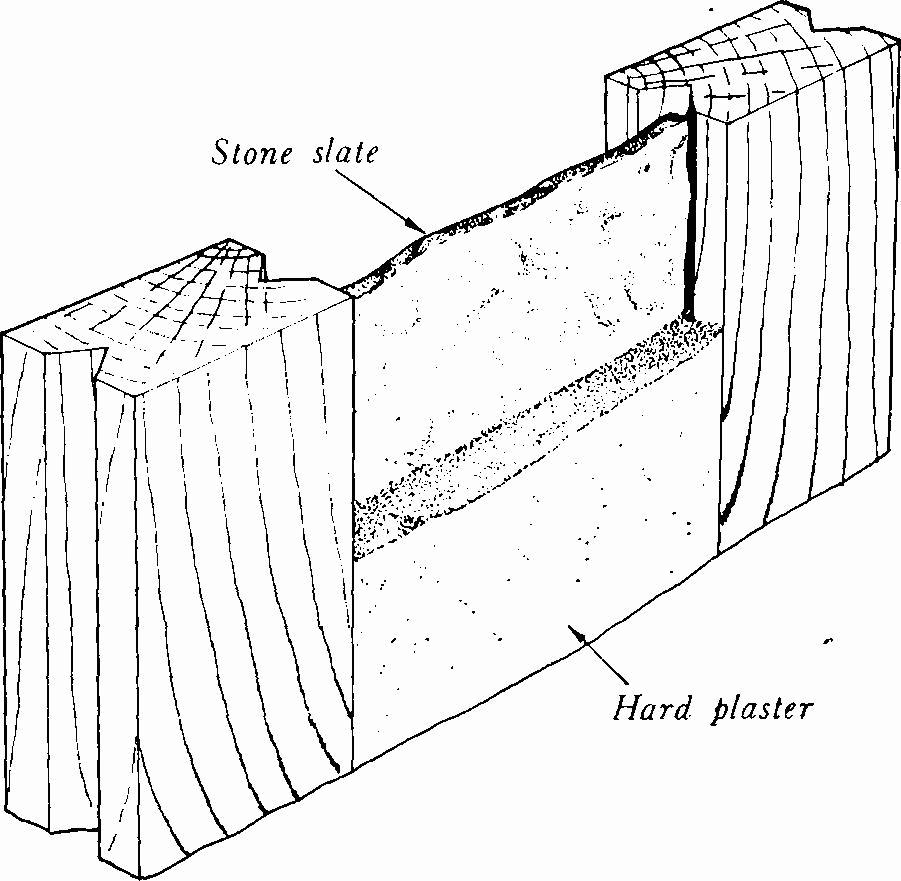
Fig. 103 (176) Gothic House
Detail of infilling in timber-frame.
The S. section giving onto the street is of three storeys and attics and the walls are probably brick but the front is rendered to imitate timber-framing (Plate 163). Twin bay windows and gables with carved barge-boards face the street. Between the bays is the date 'MDCCCXLIX' but this is now obscured. The interior has been gutted.
(177) House, Nos. 11–12 (Plate 141), two storeys and attics, timber-framed with later stone end wall, comprises a front range of the 16th or early 17th century (class 2 plan), and a slightly later parallel rear range; the main front was jettied, now only traceable in the E. end wall. In the 18th century two three-storey bay windows were added; they rise above the eaves and have canted sides and semi-octagonal hipped roofs. The rear wall, slightly jettied, has exposed timber studs marked with Roman numbers. In the E. end wall is a four-light wooden ovolo-moulded window. Inside, on the first floor, the absence of mortices in some studs implies former, smaller, windows in the positions of the 18th-century bays. In the rear wall are two rectangular oriel windows carried on brackets; they are probably replacements.
(178) House, No. 14 (Plate 92), three storeys, cellar and attics, has dressed stone walls and some timber-framing now mostly internal. The earliest, perhaps late medieval, structure of which there is evidence is a rear wing, of timber-frame with a stone stack on the E. side; its roof has a pair of collared rafters. In c. 1700 the S. range next to the street was rebuilt in stone; it extended back as far as the early stack. At about the same time a two-storey block with full-height bay window, now demolished, was built N. of the stack. The ashlared street front of c. 1700 is decorated with bolection-moulded framework defining panels and windows. The wide eaves are supported on shaped brackets (Plate 123). Inside, a staircase of c. 1700 exists on the first and second floors of the S. range, the scar of its lower flight being traceable against the S. face of the chimney stack; it has a continuous mast-like newel, square end-newels, heavy moulded hand rail, turned balusters and closed string (Plate 132). The first-floor room had until recently bolection-moulded panelling in two heights with elaborately moulded cornice and pulvinated frieze. Some early 19th-century wall-paper with a coffered pattern was noted. In the rear range there was formerly a bolection-moulded fireplace surround of c. 1700; the stone jambs of another surround with recessed mouldings survive.

Fig. 104 (178) Range behind 14 High Street
Section of roof of middle block, c. 1700.
Parallel to the main house and facing Silver Lane is a long range of three dates: the larger and central block of c. 1700 has two storeys and attics, stone walls, and is undivided internally; the roof has principal rafters with curved feet, and collars (Fig. 104). The S. block, of ashlar with moulded window surrounds, linked with the main house, is early 18th-century and of two storeys; an upper room has fielded panelling of two heights. The small block on the N. is two-storey and late 18th-century.
(179) Houses And Shops, Nos. 15–17 (Plate 92), three storeys and attics, ashlar front and coursed rubble rear walls, timber-framed stair turrets, were built c. 1700. The street fronts conform generally to the design of No. 14 but the deep bracketed eaves are lower (Plates 122, 123). The segmental-headed dormers are 19th-century. The houses originally had class 15 plans but the ground floor has been entirely gutted for modern shops, and at the rear various later additions have been made. The upper stages of the street elevations are ornamented by moulded ribs which form architraves to the windows and string-courses at lintel level; vertical ribs denote the tenements which are each of three bays. No. 17 is elaborated by further vertical ribbing; the triple window with cornice and pediment on the first floor replaces a bow window shown in this position in 1804 by Nattes. No. 15, seen before the present shop front was installed, had the jambs of tall ground-floor openings probably implying that the row was originally designed for shops; the ashlar jambs were rebated, and framed by bolection-moulded ribs.
Behind each house was a square timber-framed stair turret. That behind No. 15 was removed in 1970–1; the stair in No. 16, with splat balusters, moulded string and handrail and square newels, alone survives (Fig. 15). Between the turrets of Nos. 16–17 a timber-framed gallery, of two storeys, the upper jettied, was added in the 18th century. At the rear are a number of ranges dating from the 18th and early 19th centuries.
(180) Houses and Shops, Nos. 18–19, three storeys, attics and cellar, ashlar front and rubble rear walls, were built between 1719 and 1736; side walls are partly timber-framed but no earlier structure is traceable. This is probably the building described by Stukeley in 1736 as 'entirely new built, pulled down by Mr. Moore father of the present owner' (Stanfordia Illustrata ii, 102); a Thomas Moore bought two houses in High Street in 1719 (Court Rolls). Later in the 18th century a pair of dignified shop fronts was added, possibly replacing earlier shop windows of which four ovolo-moulded jambs survive; an apothecary's workshop was also built in the yard. The E. shop remained a chemist's until c. 1968 (Pl. 93). The building demolished after 1719 had 'a room wainscoted, upon every panel the monogram . . . IHS painted and inlayd with gold, very thick and splendid', and a chimney-piece with arms said to be of Edward III (Stanfordia Illustrata ii, 102, 116).

Fig. 105 (180) Apothecary's workshop behind 18–19 High Street
Plan, sections and elevation.
The five-bay street front has upper windows with moulded architraves and fluted keystones, spaced rusticated quoins, platband, and plain parapet with pilasters rising above a shallow moulded cornice; one surviving lead rainwater head is inscribed 'TMM' for Thomas Mills, druggist (died 1839). The shop fronts, separated by a central passage, have eight wooden fluted Corinthian columns supporting an architrave with panelled soffit, frieze fluted over the doorways, and cornice; the smaller front on the W. has been removed except for the end columns, and the window and door arrangement of the E. front recently altered. The rear elevation has windows with wooden lintels and the doorways have freestone lintels with keystones. The ground-floor plan, originally consisting of two dwellings of classes 9 and 13, has been destroyed except for a central passage, probably an original feature, which separated them; the stair, rebuilt in the 19th century, has modern lower flights. The first-floor rooms are arranged in double depth. Original fielded panelling remains in some upper rooms in one of which is an internal porch; beadedpanelled window reveals and a mahogany glazed cupboard in an alcove are early 19th-century. On the second floor fireplaces have wooden bolection-moulded surrounds of the early 18th century. The attic floors are of plaster laid on reeds or straw.
A four-bay rear wing of two storeys and attics, with brick walls, is early 19th-century. The recentlydestroyed late 18th-century apothecary's workshop of three bays, of one storey and attic in mansard roof, was of ashlar and brick. The main compartment had a barrel-vault above which was a plaster floor to the attic; in the rear wall were round-headed recesses containing later boilers etc. (Fig. 105).
(181) House, No. 20, front of three storeys and attics in a hipped mansard roof, rear section of two storeys under pitched roof, parapet, ashlar front, rubble rear wall, has a class 13b plan. It was built in c. 1820 in which year Thomas Mills, druggist, leased the site from the Marquess of Exeter (Ex. MS). The two-bay street front has upper windows with moulded surrounds, keystones and moulded sills; below is a modern shop. It generally conforms with Mills' own house adjoining (180).
(182) House, No. 21 (Plate 101), on a corner site, three storeys and attics, ashlar-fronted, originally class 10 plan with stacks in the rear wall, was built in 1732. This date with initials 'HI', probably for Humphry Iliffe, is inscribed on the surviving chimney stack, together with the date '1793' and initials 'TSE' for Thomas Snow, upholsterer, and his wife Elizabeth. Snow bought the property in 1792 having leased it for several years, and dated rainwater heads bear his initials 'TS 1801' (deeds at No. 3 St. Leonard's Street).
The main front, in Ironmonger Street, has a central round-headed doorway set in horizontally rusticated walling almost totally removed by later shop fronts. The upper storeys on both elevations exhibit an elaborate design articulated by fluted pilasters which accentuate the central entrance bay on the E. The pilasters with bases at first-floor level carry separate architraves, friezes with triglyphs, and a continuous moulded cornice below a plain parapet. The five-bay E. front and two-bay S. front have platbands at sill level; the windows have exaggerated voussoirs and moulded surrounds interrupted by rusticated blocks (Fig. 10). Interior fittings are limited to windows with moulded architraves and beaded side panelling of the early 19th century. The ground floor had become a shop by 1804 (Nattes' drawing), but in 1836 the present shop front was installed by the proprietor Richard Knight who is recorded as adding 'several elegant windows' (Mercury, 6 May 1836). These shop windows are on both elevations and have classical columns, some round, some square, and modern plate glass.
(183) Undercroft (Fig. 106; Plate 59), beneath No. 23, with coursed rubble walls, and quadripartite vault of segmental section, is of medieval date. The diagonal ribs run down to the modern floor level, the remainder die into the wall; all are heavily projecting and chamfered. The S.W. diagonal rib divides in order to accommodate a doorway in the S. wall. This S. doorway, approached by a flight of steps, although much restored retains some part of the original internally rebated and externally chamfered jambs. The web of the vault on the N. rises higher than elsewhere so as to avoid an opening in the N. wall; this opening is now a doorway but doubtless replaces an original feature, probably a window. To the E. is a segmentallyvaulted compartment opening off the main undercroft with which it is apparently contemporary. The axial rib of the main vault is carried on the keystone of the outer arch of the compartment. In the back wall is a recess of uncertain date.

Fig. 106 (183) 23 High Street
Plan of undercroft.
(184) House, Nos. 25–26 (Fig. 107; Plate 99), originated as a timber-framed structure of the early 17th century, probably comprising three rooms with continuous jetty facing the street. In 1645 a stone-built wing was added at the rear and at sometime in the 17th century the back wall of the main range was replaced in stone. Early in the 18th century the street front was heightened and encased and a further wing, jettied on the E., was added at the rear; this resulted in a pair of houses of classes 9 and 13. Refitting in the early 19th century included a central staircase and shop fronts.
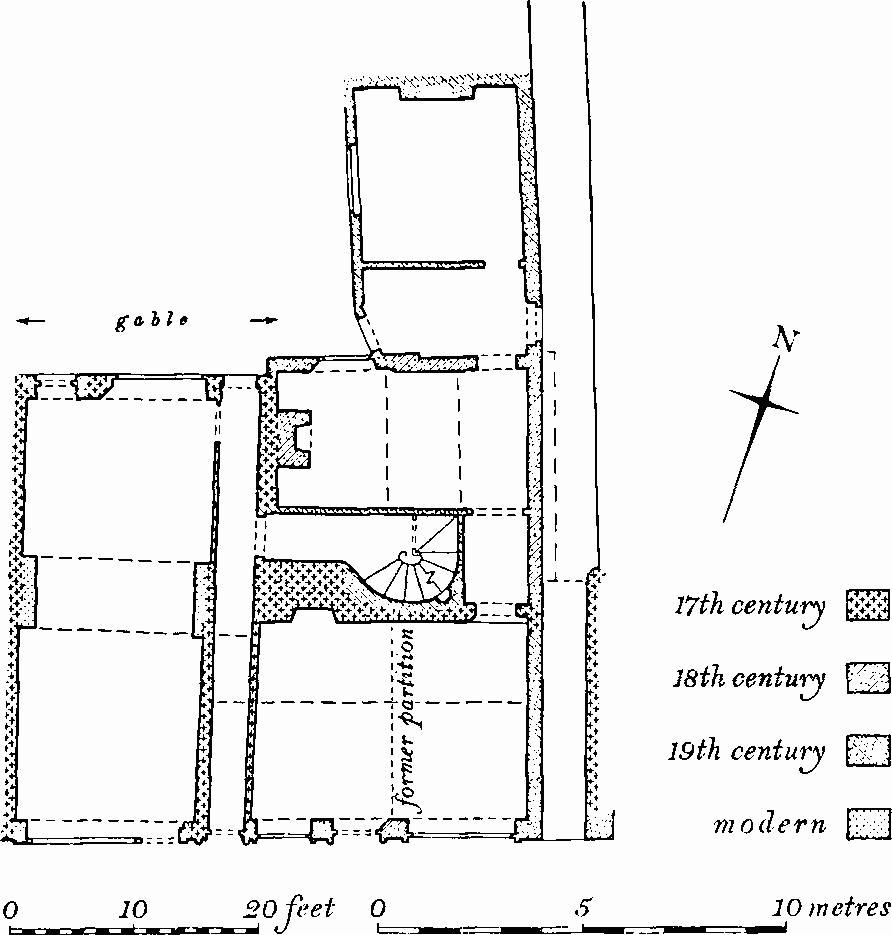
Fig. 107 (184) 25–26 High Street.
The front elevation, of three storeys and attics, has ashlar wall above the shop fronts. The windows, arranged as three pairs, have eared surrounds which step up at the centre of the head (Fig. 10); single-sheet glazing recently replaced sash windows. A platband and continuous sills stop short of the rusticated quoins. A moulded cornice is independent of the quoins. Early 19th-century shop fronts largely survive and consist of two doorways with classical columns between shop windows; in the end bay is a plain opening to a public footpath. Inside, ceiling beams in the front range indicate former axial and cross partitions; in the former back wall is a 17th-century ovolo-moulded window. In the N. gable of the rear wing is a stone inscribed '1645'; the windows, originally mullioned, have hood-moulds. Fittings of the 18th century include a staircase in No. 25 with shaped splat balusters and a fireplace with a stone eared surround now containing an early 19th-century cast-iron grate with rococo decoration. Two rooms with fielded panelling have quarter-octagonal corner porches. The stair in No. 26 of the early 19th-century has turned balusters and is set in a circular well having round-headed niches at intervals.
(185) House, Nos. 28–30 (Plate 112), two storeys and attics, originated as a single, probably timber-framed, structure of unknown date. Early in the 18th century Nos. 28 and 29 were refronted in ashlar. No. 30 became a shop, and shortly before 1876 it was refronted with terracotta details of extravagant design by Blashfield (Mercury, 3 Mar.). The five-bay front of Nos. 28 and 29 has moulded plinth, platband, and a boldly projecting cornice with plain frieze; surrounds to the windows and to the central doorway have ovolo mouldings and keystones (Fig. 11). Shop fronts of c. 1830 have panelled pilasters, capitals with roundel decoration, and later glazing.
(186) House, No. 31 (Plate 111), two storeys, attics and cellar, ashlar front and coursed rubble rear walls, is stylistically of c. 1740. The ground stage of the street front has been removed for a shop, but above, the wall has quoins alternately rusticated and beaded on the arris. The windows have rounded surrounds of unusual but doubtless original profile. The widely projecting eaves are carried on a heavy modillion cornice. On the ground floor the quoins have been reset further E. beyond the modern shop front. Inside, the plan probably conformed to class 13b with the present modern stairs in the position of the original. In an upper room is 18th-century panelling in two heights with bolectiontype moulding, dado rail and wooden cornice.
(187) House, No. 40, originally one storey and attics, raised to two storeys and attics in the later 19th century, has stone walls and is probably 17th-century. It consists of a single ground-floor room and a side passage, the 17th-century doorway to which has four-centred head and chamfered jambs in a rectangular wave-moulded surround.
(188) House, No. 41 (Plate 105), two storeys, ashlar walls, large and small unchamfered quoins (Plate 121), was totally reconstructed as a shop in recent years. It was built in the mid 18th century and some architectural elements of this date have been reset in the present building the upper storey of which bears a superficial resemblance to the original. The ground floor is completely modern. The main front is on the W.; the three upper windows have moulded surrounds, eared at head and foot, and triple keystones (Fig. 10). The centre part of the wall extends above a renewed wooden dentilled cornice as a decorative frontispiece with shaped cheeks and a pediment enclosing branch-sprays; on the face is a cartouche with scrolled surround, formerly bearing the letters 'JSL' and crest (demi eagle with wings displayed). Before the recent rebuilding, there was an early 19th-century shop front occupying two bays, and an adjacent window with plain surround and triple keystone, all below a platband; the parapeted gables terminated with central chimney stacks, and there were dormer windows. The N. elevation now has a first-floor window uniform with those on the W. but with a pediment. No early features survive internally. At the N.E. corner of the modern E. range is a one-stage buttress with weathered top, of uncertain antiquity.
House, Nos. 46–47, demolished in 1966. Medieval doorway reset at (253) Maiden Lane (q.v.).

Fig. 108 (189) 51 High Street (demolished).
(189) House, No. 51 (Fig. 108), was demolished in 1966. It originated as a three-storey late medieval timber-framed house with an L-shaped plan and first-floor jetty (class 3); the compartment W. of the central passage was originally divided into two rooms. In the 17th century a rectangular bay window was added, and later the jetty was largely under-built. A second bay window with canted sides was added in the 18th century, and a new roof constructed, lower on the E. than on the W. The N. elevation (Plate 82) had an 18th-century central stone doorway with moulded architrave and cornice, and pulvinated frieze. The rectangular bay window had stone mullions on the lower two floors, but the top storey was an 18th-century addition of timber. On the extension of the rear wing was a plaster panel dated 1690 and a representation of a windmill in the pargetting. Inside, the E. room had an original stack in the rear wall. In the 18th century the ceiling was raised and the room fitted with a plaster cornice containing heads in roundels, and urns, linked by swags; a chair rail with rosettes and a mahogany veneered door with decorative inlay and enriched architrave were also added. The W. room was sub-divided until c. 1600 when the E. wall was painted with floral decoration (Plate 85). Built into the chimney was a limestone panel (Plate 33), now in Stamford Museum, inscribed:
'Vous qen ceste mesoun entrez
pur Blau(n)che fem(m)e al seign(eur) Wake p(ri)ez
file al counte de Lancastre Henri
as queux dieux face vraye merci'
Lady Wake, daughter of Henry, Earl of Lancaster, died in 1380 and was buried in the Greyfriars, Stamford.
(190) House, No. 53, two storeys and cellar, class 4, almost entirely rebuilt in recent years using some earlier materials. A jetty on the N. is preserved (see Stamford Report I, no. 66, p. 48).
(191) Houses, Nos. 54–55 (Fig. 109; Plate 93), originated as a two-storey timber-framed building of the early 16th century. It comprises two ranges: one, of class 2 plan, faces High Street and is jettied on that side; the other, slightly later, is parallel to Cheyne Lane and jettied on both sides. In the late 17th century the jetty of the street range, on the N., was under-built in masonry, apparently with a shop front. The same range was heightened to three storeys in the first half of the 18th century, given a new roof having principal rafters with curved feet, and provided with an ashlar front elevation. The lower part of a large chimney stack at the junction of the two ranges was removed in this century.
The street front, of ashlar, has rusticated quoins, moulded window surrounds with keystones, platband, block cornice and a parapet. On the ground floor a section of the 17th-century under-building of the original jetty remains in the N.W. corner; it consists of a moulded pilaster with vertical ribs, and there is indication of a large window opening on the main front with a horizontal rib beneath the sill (Fig. 110); the feature is repeated midway along the front. The whole length of the W. side is jettied, but at the junction of the two blocks the overhang varies suggesting marginally different dates for the ranges. The rear range remains two-storeyed, but no original openings survive.
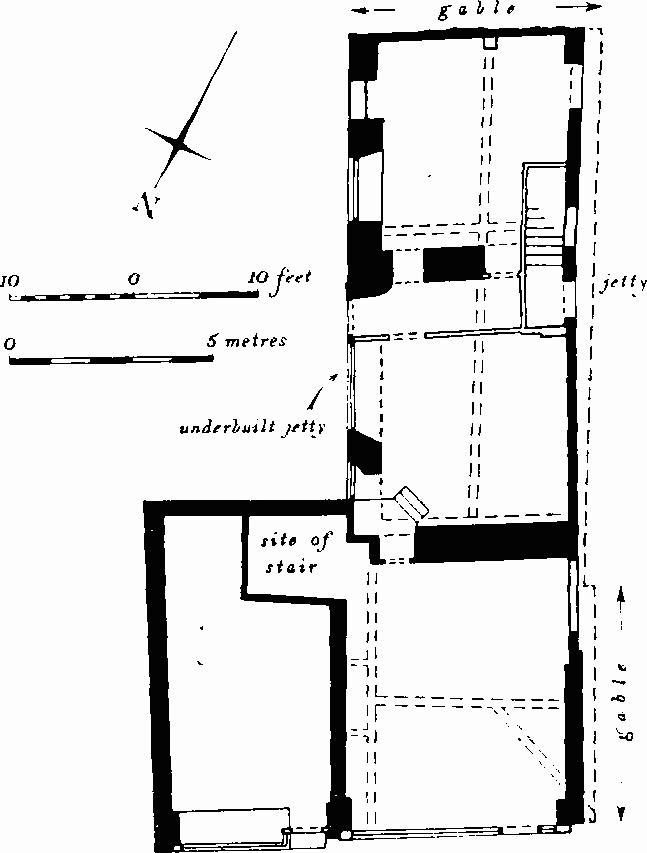
Fig. 109 (191) 54–55 High Street.
Internally, the main range has wave-moulded axial beams and a dragon beam at the N.W. corner. In the angle of the two ranges was a timber-framed 18th-century stair turret, now surviving only on the upper floors; the stair has turned balusters with square knops. One room retains a fireplace with eared surround and moulded shelf. In the rear range are axial beams with mouldings similar to those in the main range, but other beams are encased. The original arrangement of rooms in this range is not clear but it may have consisted only of two rooms on the ground floor. The roof, of three bays, has tie beams with arch braces to swell-headed posts.
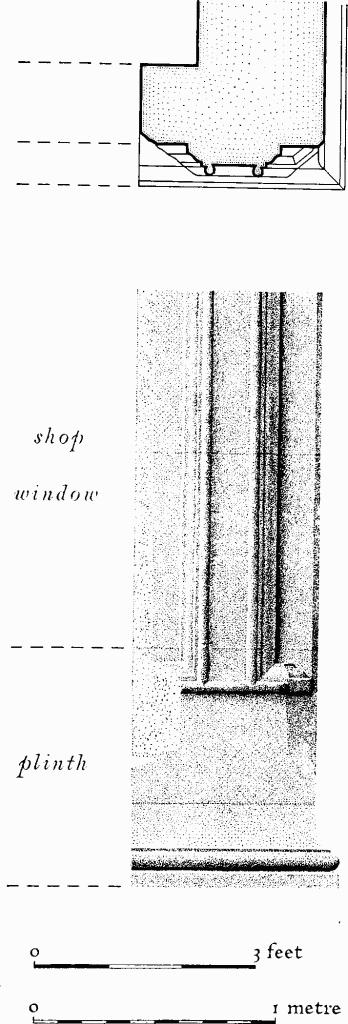
Fig. 110 (191) 54–55 High Street
Remains of 17th-century shop front.
(192) House, No. 56, three-storey main range, twostorey rear wing, resembling class 5; originally timber-framed throughout but the street front was cased in stone in the early 19th century. It is probably 16th-century but has had a number of later alterations. The main building is L-shaped with a jetty along the full length of its E. side, facing Cheyne Lane, and the remains of a second jetty on the W. side of the rear wing. The long jetty is carried on six unchamfered brackets and stops at its S. end against a corbelled-out masonry wall, originally the S. gable wall of the wing; the W. jetty is largely hidden by a long 19th-century bay window. The wing was extended first in coursed rubble in the 17th century, then in brick in the early 19th. The roof of the front range is asymmetrical; the ridge is centred over the front part and the eaves on the street side are higher than those at the rear. The street front has a long early 19th-century shop front with pilasters; the upper part of the wall is in three bays with sash windows and continuous sills. Inside, the front range has an axial, cased beam placed off-centre, perhaps suggesting a former passage at the rear of the front room; on the third floor such a passage exists. The rear range has a thick S. gable wall incorporating a chimney stack, but this has been removed on the ground floor. The ceiling has intersecting beams with wave-andhollow mouldings. On the first floor, the wing has a central and two terminal tie beams supported by arch braces from swell-headed posts; the roof has clasped purlins and wind-braces. In the W. wall the absence of peg-holes in the wall plate indicates two former windows. Later fittings include an early 18th-century bolection-moulded overmantel in three panels.
(193) House, No. 57, of two and three storeys, cellars, with ashlar walls, consists of an early 18th-century street block and a rear wing, possibly contemporary, with small projecting closet at its far end. The front elevation is late 19th-century in a mid 18th-century style. The windows of the rear wing have moulded architraves and fluted keystones. The ground floor has been gutted for a shop, but on the first floor an early 18th-century wooden cornice remains (Plate 123). In the rear wing is a mid 18th-century cupboard with rounded head, key block and semi-dome painted with scene of frolicking cupids with bunches of grapes.
(194) House, No. 59 (Plate 92), formerly the Pineapple Inn, three storeys and attics, has a wide eaves cornice supported on moulded brackets (Plate 123), ashlar front wall with bold quoins, platband, and windows with moulded architraves; it was built in the early 18th century. The roof with clasped purlins remains.
(195) House, No. 63, three storeys, ashlar front, class 14b, probably dates from 1819 when the freehold was sold (Mercury, 15th Oct.). It was then described as good and substantial and having a shop, counting house, two good parlours and four bedrooms. The ground floor has been gutted for a modern shop.
(196) House, No. 64, two storeys and attics, ashlar front and rubble rear walls, has a class 12 plan; ground floor partitions have since been removed. It was built in the first half of the 18th century but the plain two-bay front wall is early 19th-century. The rear wing has windows with emphasized keystones and heavy glazing bars. Inside, the first-floor rooms have fielded panelling of two heights and wooden cornices; off the front room is an original closet. The stair, of which only the upper flights survive, has turned balusters, cut string with scrolls decorated with rosettes, and ramped and moulded hand rail.
(197) House, Nos. 68–69, two storeys, is 18th-century. The ashlar front wall has bold quoins, platband, two pairs of first-floor windows with moulded architraves and plain keystones. The remainder is much altered and rebuilt.
(198) House, No. 70, two storeys, attics and cellar, stone walls, is 18th-century. The ground floor, originally conforming to class 14b, has been entirely gutted except for an internal side passage. One room has an 18th-century wooden cornice. The house was extended at the rear twice in the early 19th century, first in brick then in stone.
(199) House, No. 71, three storeys and cellar, with ashlar front elevation having platband between upper storeys, was built c. 1820–30; soon afterwards two warehouses each of two storeys were added at the rear. The house, comprising a single room on each floor and a kitchen in the cellar (class 15), has a plain but elegant semicircular staircase behind a chimney stack. The first-floor room contains a fireplace with angle-roundels and a plaster ceiling with Greek key pattern. The first warehouse has brick walls, the second stone, and both have mansard roofs.
(200) House, No. 72, two storeys and attics, ashlar front and rubble rear walls, class 10 plan, is mid 18th-century. The front has rusticated quoins, and four upper windows with continuous sills, moulded architraves and keystones; the ground floor has been gutted for modern shop. Rooms on the first floor, originally arranged in double depth, contain 18th-century moulded door architraves.
(201) House and Shop, No. 74, three storeys and attics, coursed rubble with freestone dressings, class 10 plan, sash windows, moulded stone cornice to gabled roof, was described as being newly built and having a large shop when it was sold in 1840 by St. John's Rectory (Ex. MS, 63/2 1–7). The present shop front is modern.